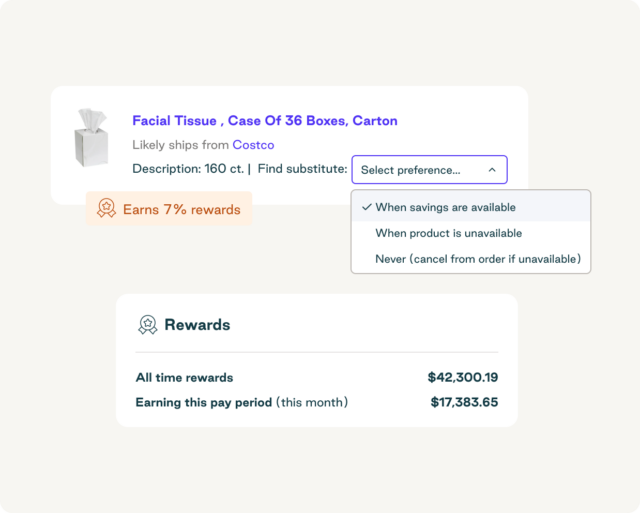Centralized Purchasing & Procurement: Simplifying Your Buying Process to Reduce Costs

Centralized Purchasing & Procurement: Simplifying Your Buying Process to Reduce Costs
Startups and smaller companies often approach procurement with a “get what you need to make the business run” mentality. This may work for those with lower purchasing volumes—but as organizations grow, their buying processes must evolve to maintain cost efficiency and scalability.
That evolution often includes adopting the centralized purchasing model to enhance the procurement process. Centralized purchasing techniques and tools help coordinate spending across organizations, resulting in greater visibility and control over costs.
To realize these benefits, you need a clear understanding of how centralized purchasing really works. This guide explores its pros and cons, details best practices for successful implementation, and provides an ideal organizational blueprint you can follow.
Download the free guide: Spend Analysis Toolkit
What is centralized purchasing?
Centralized purchasing is the process of unifying all procurement across departments and locations within a single technology solution. Every purchase follows a standardized workflow, ensuring alignment with company spending policies.
In contrast, decentralized procurement makes it harder to monitor orders, pinpoint duplication, and reduce waste. It’s also labor-intensive, requiring stakeholders to repeat tasks. Without visibility and spend aggregation, it's easy to lose leverage for bulk pricing discounts and favorable contract terms.
Even single-location businesses can benefit from centralization by coordinating purchasing decisions across teams. For multi-location organizations, centralization goes further by enabling unified vendor management, consolidated payments, and efficient distribution of goods across sites.
Franchises are a prime example. By using centralized procurement software and shared vendors, they can present uniform products and experiences across independently owned locations.

Is group purchasing the same as centralized purchasing?
Where centralization consolidates internal purchasing power within your company, group purchasing—engaging the services of a group purchasing organization (GPO)—leverages the purchasing volume of multiple companies (group members) to control costs and share volume discount benefits.
The main differences between centralized and group purchasing are as follows:
| Feature | Group purchasing | Centralized purchasing |
| Organizational structure | A separate business entity that serves multiple companies | An entire organization, a single department, or a team within an organization |
| Control | Your organization chooses whether to use the GPO’s pre-negotiated contracts or your own vendors | Your central procurement team has complete control over all purchasing decisions |
| Vendor relationships | The GPO manages pre-vetted supplier relationships on your behalf | Your central team manages all aspects of your vendor relationships |
| Cost structure | Your membership fees cover GPO purchasing support | Your procurement budget funds all purchasing activities |
Even if you take advantage of the benefits of a centralized purchasing process, you can still use a GPO. In fact, the two approaches often complement each other rather than conflict. Organizations that employ both may use centralized purchasing to manage policies, approvals, and supplier relationships internally while relying on a GPO for greater buying power, better pricing, and improved terms.
8 Core advantages of centralized purchasing
Centralized purchasing simplifies processes and reduces procurement costs. It encourages policy adherence while eliminating the inefficiencies that sap productivity and limit your spend visibility.
Here are eight ways centralized purchasing helps drive procurement efficiency:
- Reduces procurement costs: Centralized procurement management saves money by preventing duplicate orders, off-policy purchasing, and other instances of wasteful spending. It also improves access to volume discounts and lowers shipping fees.
- Eliminates maverick spend: By centralizing your procurement function, you establish tighter spend controls and an automated approval process that prevents purchases outside company policies.
- Simplifies ordering: A centralized purchasing workflow reduces the time it takes to request, approve, and order supplies. Automated approval hierarchies and consolidated supplier catalogs mean fewer bottlenecks in your ordering process.
- Unlocks discounts on bulk orders: With a centralized purchasing model, you can easily access volume discounts by consolidating multiple purchases from the same vendor into one collective order.
- Reduces shipping fees: By reducing the number of orders per vendor, centralized purchasing helps you achieve better shipping rates. Similarly, some vendors offer free or reduced shipping rates for bulk orders.
- Reduces invoices: Centralized purchasing consolidates vendors and orders, minimizing the number of invoices your AP team needs to process.
- Saves time: With fewer invoices to reconcile, your accounting department spends considerably less time on month-end close and tax preparation.
- Ensures consistent quality across locations: A centralized purchasing system standardizes vendors and products across your organization, ensuring the same customer experience at every location.
What are the limitations of centralized purchasing?
Centralized purchasing transforms procurement from a labor-intensive and confusing process into a cost-saving, productivity-boosting asset. But it’s not without its challenges.
Before implementing centralized purchasing, consider these potential limitations:
- A poor process drives poor results. Purchasing centralization relies on a strategic approach and optimized systems. Establish trigger points for each stage in the purchasing process and develop a well-documented purchasing policy to prevent maverick spending.
- Adoption is critical to success. There’s little benefit to centralized purchasing if your team doesn’t adhere to the new ways of working. Ensure clear documentation, adequate staff training programs, and company-wide stakeholder involvement to maximize user adoption.
- The right technology is paramount. Even with optimized processes and high user adoption, you need the right tools to unlock the full benefits of centralization. Use procurement technology to automate and simplify your purchasing process while minimizing the manual effort of unifying critical data and workflows.
These challenges become more manageable with the right strategy, tools, and change management plan. As long as you build it on a strong foundation, centralization delivers significant value.
When should you implement centralized purchasing?
Despite the benefits of centralizing purchasing and AP processes, many organizations (especially small businesses) soldier on with manual systems. In fact, over 40% of respondents in a recent study said that efficiency and complexity are the top procurement challenges at their organization.
With the right platform, it’s never too early to centralize. The sooner you embrace technology, the simpler and more effective your procurement and purchasing processes become.
Here are 10 signs it’s time to centralize your purchasing process:
- Finance finds frequent and recurring discrepancies in purchasing data across different departments.
- The price paid for the same goods or services differs by department or location.
- The procurement process is time-consuming and involves redundant efforts from several departments, multiple vendor invoices for the same goods, and excessive research into issues.
- There is a lack of transparency and accountability in procurement, making spend management challenging.
- You struggle to maintain a strategic procurement strategy and resort to transactional supplier relationships due to siloed negotiations and inconsistent contract management.
- The finance team notices an increasing amount of maverick spend or purchases made outside of preferred agreements and systems.
- Inventory management becomes a hassle, with excess stock in some areas and shortages in others.
- Your organization lacks a unified strategy for sustainability and social responsibility in procurement activities.
- Administrative costs associated with processing purchase orders continue to rise, including labor costs for processing manual orders and payments.
- You don't have complete procurement data from all locations, making it difficult or impossible to analyze spending and trends or forecast future demand.

The ideal organizational blueprint for centralized purchasing
Centralized purchasing requires more than simply updating your policies and investing in new technologies—it requires a drastic shift in how your business operates. Here are the three fundamental steps for successful implementation.
Decide on a governance model
Governance defines who has the authority to make strategic purchasing decisions, create policies and frameworks, and approve purchases. There are several models you can choose from, including:
- Fully centralized model: Your central procurement team has absolute authority over all purchasing decisions. Other departments can submit requisitions, but the central team handles approvals, sourcing, and purchasing.
- Hybrid model: Your central procurement team sets the overall strategy, including defining policies, choosing which tools to use, and managing vendor relationships. They can delegate authority for specific buying activities to other teams, but they still establish the framework those teams must follow.
- Shared-authority model: All purchasing decisions are made by a cross-functional committee that includes members from the central procurement team and other business units, such as finance and operations.
As Tracey Shearer, Managing Director of August Consulting, explains, “The choice of procurement operating model is an ongoing journey of optimization and adaptation. Success lies in creating a structure that can evolve with your business objectives.”
Define roles and responsibilities
To establish accountability and avoid confusion, assign specific roles to different teams or employees and clearly define the responsibilities for each.
Here are some key roles to include in your organizational structure:
- Chief procurement officer (CPO): Sets the vision, aligns your strategy with corporate goals, and owns the overall performance of the procurement function
- Category manager: Develops category strategy, manages supplier relationships, and ensures targets are met
- Procurement manager: Handles strategic sourcing, conducts contract negotiations, and manages the central procurement team
- Procurement analyst: Oversees spend analytics, monitors KPIs, and translates data insights into actionable responses
- Procure-to-pay (P2P) manager: Manages the entire P2P cycle, from requisition to purchase order, and resolves invoice discrepancies
- Cross-functional liaison: Listens to and communicates the needs of various stakeholders across teams and guides them through the procurement process
Depending on the size and structure of your staff, some of these roles may be assigned to more than one person. Conversely, a single employee may be responsible for multiple roles.
Create a change management plan
Change management is the driving force behind successful user adoption. It’s key to securing stakeholder buy-in and preventing employees from reverting to old habits after implementation.
Your change management plan should include:
- Communication: Create a clear and compelling narrative that explains why you’re centralizing purchasing. Tailor your messaging to highlight the specific benefits for different groups within your organization.
- Change champions: Involve influential sponsors of the upcoming change—such as your CEO, CFO, or COO—and have them act as advocates to encourage user adoption among teams.
- Stakeholder involvement: Work with different teams to establish a sense of ownership and inclusion when sharing your implementation strategy.
- Phases: Plan your implementation in distinct phases to identify and correct issues on a small scale. For example, focus on centralizing purchasing for one specific spend category or product line at a time.
- Training: Provide comprehensive employee training for any new processes and ongoing support to help staff adapt to the new ways of working.

Technology requirements and platform considerations
Certain procurement software features are essential for supporting purchasing centralization and ensuring your new strategy succeeds. Before you select a system, it’s helpful to define the functionality criteria that best meet your organization's needs.
When considering new procurement technologies, focus on:
- Eprocurement tools: User-friendly, consolidated purchasing tools that guide employees to purchase from pre-approved suppliers
- Spend analytics: Detailed, real-time reporting dashboards and KPI monitoring for improving spend visibility
- Supplier relationship management: A central system for managing vendor contracts, monitoring supplier performance, and automating supplier onboarding
- Centralized sourcing: Specific tools for strategically sourcing goods to standardize quality, consolidate purchasing, and reduce costs
- Software integrations and API readiness: Built-in integrations and API accessibility that connect your purchasing system with other financial and operational software tools for accurate, real-time data synchronization
Consolidate buying with the right centralized purchasing solution
The simplest way to bring all your purchasing activities together is with a sophisticated procurement solution. A centralized platform lets employees from individual departments and locations order what they need, while your organization benefits from simplified purchasing, automatic consolidation of important procurement data, and smoother operations.
With Order.co, you can manage every part of the procurement process, from sourcing to invoice reconciliation. The platform helps reduce your accounting team's workload and increase efficiency with features like automatic general ledger (GL) coding, three-way matching, and an easy payment process.
If you're ready to simplify purchasing, save money, and reclaim time, get in touch today to request a demo.
Get started
Schedule a demo to see how Order.co can simplify buying for your business.
"*" indicates required fields



